Nestled in a bend in the Mississippi River, Saint Paul, Minnesota, has long been a cultural crossroads as a trading and transportation center and as the capital of Minnesota.
Today it is a quiet multicultural city of museums, parks, colleges, and great food from around the world.
Exploring Saint Paul
For a rather quiet place, Saint Paul offers a wealth of art, culture, intellectual, and dining opportunities. There are also inviting parks, well-preserved historic buildings, and a growing craft beer industry. With a diverse population that includes large Mexican-American, Hmong, and Somali communities, it’s easy to experience several cultures in a single day!
Downtown, Lowertown, and the State Capitol
 Sitting along the banks of the Mississippi River, downtown Saint Paul has a lot to offer visitors. The city’s business district is located in the center of downtown, but there is a lot more than business happening here. This is the city’s cultural heart, with a variety of museums, theaters, parks, and historical buildings.
Sitting along the banks of the Mississippi River, downtown Saint Paul has a lot to offer visitors. The city’s business district is located in the center of downtown, but there is a lot more than business happening here. This is the city’s cultural heart, with a variety of museums, theaters, parks, and historical buildings.
- After Dark at Mickey’s Dinner (June 2014)
- Waiting for the Parade and Saint Patrick’s Day in Saint Paul (March 17, 2010)
Just beyond the business district, Lowertown is becoming the hip place to live in Saint Paul, with new bars and restaurants popping up everywhere. The farmers market has been here for decades, but the nearby CHS Field (home of the Saints baseball team) is brand new, and Union Depot was only recently polished up and put back into use as a rail station. Fortunately at least some of the artists who put Lowertown on the cultural map in the first place still have studios here and there are still galleries, performance spaces, and art events that showcase their work.
- End of summer at the Saint Paul farmers market (September 2015)
- Shimmering Sculpture at Union Depot (April 2014)
- Waiting for the Trains (April 2014)
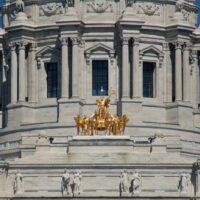 Just uphill, the regal Minnesota State Capitol is in the midst of a renovation that will bring it back to its original beauty. Renovation tours are available and much of the surrounding grounds and sculptures are still open to the public.
Just uphill, the regal Minnesota State Capitol is in the midst of a renovation that will bring it back to its original beauty. Renovation tours are available and much of the surrounding grounds and sculptures are still open to the public.
- Faded Beauty at the Minnesota State Capitol (January 2014)
West 7th
This old neighborhood southwest of downtown is undergoing tremendous change, but the history of the area, once a European immigrant community anchored by the former Schmidt Brewery, is still evident in its restaurants, antique shops, galleries, and micro-breweries. With downtown and the Xcel Energy Center (home of the Minnesota Wild) nearby, West 7th is a busy place from happy hour until late into the evening.
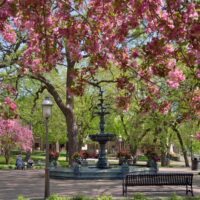 Nearby, tiny Irvine Park is where Saint Paul was established as a city in 1849. This historic neighborhood is the perfect place to stroll and a glimpse of the city’s past.
Nearby, tiny Irvine Park is where Saint Paul was established as a city in 1849. This historic neighborhood is the perfect place to stroll and a glimpse of the city’s past.
- Spring Arrives in Irvine Park (May 2014)
Summit-University and west to River Road
The Summit-University area includes several neighborhoods on Cathedral Hill and along Summit and University Avenues to Minneapolis.
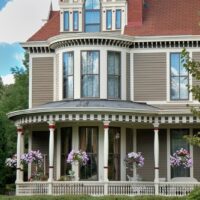 Cathedral Hill sits on the bluff above downtown, anchored by the Catholic Cathedral of Saint Paul. This was a breezy, largely rural area in 1891 when railroad magnet James J. Hill built his home here. Saint Paul’s elite soon followed, erecting mansions along Summit Avenue and throughout the surrounding neighborhood. It’s a great neighborhood for walking.
Cathedral Hill sits on the bluff above downtown, anchored by the Catholic Cathedral of Saint Paul. This was a breezy, largely rural area in 1891 when railroad magnet James J. Hill built his home here. Saint Paul’s elite soon followed, erecting mansions along Summit Avenue and throughout the surrounding neighborhood. It’s a great neighborhood for walking.
Nearby Selby Avenue is the home to a few unique shops and a number of great restaurants, bakeries, and up-scale bars—many located in historic buildings.
To the south, Grand Avenue is lined with shops and restaurants from Cathedral Hill almost to the Mississippi River.
To the north, University Avenue (and the Metro Green Line) runs through some of the most diverse neighborhoods in the state. This diversity is evident in the shops, restaurants, and cultural institutions along the way. It’s also becoming an arts center, with new studios and galleries popping up. It’s a great place to get a bite to eat.
- A Hmong-Lao Memorial Day Celebration (May 2014)
Highland Park
Although it’s a desirable residential neighborhood, Highland Park has little of interest to visitors beyond River Road. This neighborhood of modest homes grew up around a (recently demolished) Ford motor vehicle assembly plant, and businesses here largely serve the surrounding neighborhood.
- Saying Good-bye to the Twin Cities Ford Plant (June 2012)
Como (including Hamlin-Midway and Saint Anthony Park)
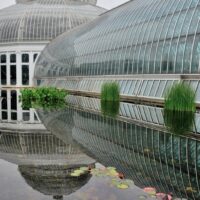 The Como area includes its namesake park, zoo, and conservatory, while Saint Anthony Park’s tiny commercial hub is a fun place to shop and grab a bite to eat.
The Como area includes its namesake park, zoo, and conservatory, while Saint Anthony Park’s tiny commercial hub is a fun place to shop and grab a bite to eat.
- University of Minnesota Display and Trial Gardens, Saint Paul Campus (August 18, 2012)
- Como Conservatory and Japanese Garden (June 2013)
- Como Park is in Bloom (May 2013)
The East Side (Payne – Phalen, Dayton’s Bluff, and the Greater East Side)
The East Side neighborhoods encompass a mix of mostly struggling neighborhoods with a broad range of housing and commercial development. Dayton’s Bluff has a notable collection of Victorian mansions as well as several popular restaurants and bars. These neighborhoods are also home to Lake Phalen, Indian Mounds, and Swede Hollow parks. It’s an interesting area of the city, but visitors should be cautious in some of these neighborhoods after dark.
The Greater East Side and Battle Creek
The Greater East Side encompasses the residential and commercial areas that grew up around 3M’s headquarters. Nearby Battle Creek is a secluded residential neighborhood. For visitors, the attraction in this part of the city is Battle Creek Regional Park.
- Into the Wayback Machine: The Dari-ette (September 2012)
Thomas-Dale and the North End
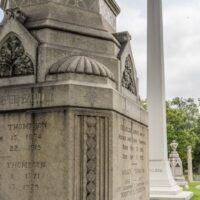 Beyond the capitol area, there is little of interest to visitors in the mostly lower-income Thomas-Dale and North End neighborhoods. There are two exceptions to that statement:
Beyond the capitol area, there is little of interest to visitors in the mostly lower-income Thomas-Dale and North End neighborhoods. There are two exceptions to that statement:
- The historic Oakland Cemetery, where many of Minnesota’s most prominent early settlers were buried
- The Half Time Rec is a popular local bar that often features Irish music and where it is not unusual to see local children showing off their Irish step dance skills
Visitors should be cautious in some areas of these neighborhoods.
The West Side
The heart of Saint Paul’s Hispanic community
River Road
Crossing several neighborhoods along both sides of the Mississippi River is Minneapolis and Saint Paul, River Road is ideal for walking or biking. The road has bike and walking paths and runs from the main campus of the University of Minnesota down to Hidden Falls Park in Saint Paul and Minnehaha Falls in Minneapolis. On the Saint Paul side the trails hug the bluff above the river, providing views of the river, lock and dam, various bridges, and Minneapolis in the distance.
- Urbanity Along the Mississippi River (July 23, 2011)
Exploring beyond Saint Paul
The eastern suburbs around Saint Paul are largely residential, but a few places warrant a trip beyond the city.
 Fort Snelling
Fort Snelling
Located on a site used by American Indian communities for generations, Fort Snelling was the first step in Minnesota’s path toward statehood. The historic fort is preserved as a historic site, while later housing and other military facilities are (finally) being put to new uses. The adjacent Fort Snelling State Park, preserves land around the confluence of the Mississippi and Minnesota Rivers.
White Bear Lake
Located north of Saint Paul, White Bear Lake is a charming lakeside community with a vibrant arts community, innovative restaurants, and unique shops.
Afton
The historic town of Afton is tiny, but it’s the perfect place to stop for an ice cream cone after a day spent exploring Afton State Park.
Stillwater
Perhaps the perfect river town, Stillwater’s Victorian architecture climbs the hillsides above the Saint Croix River. With a vast array of unique shops and restaurants, it’s the perfect place to spend a day or two.
- Christmas Shopping in Stillwater (December 2008)
Resources for planning your exploration
Saint Paul is small enough that visitors can just wander without doing a lot of planning, but there are a few resources available for those seeking more information or a more structured itinerary.
- The Saint Paul Convention and Tourist Bureau’s Visit Saint Paul website has a wealth of information for visitors
- Historic Saint Paul has a wonderful set of (free) Walking Tour Guides
All Minnesota posts